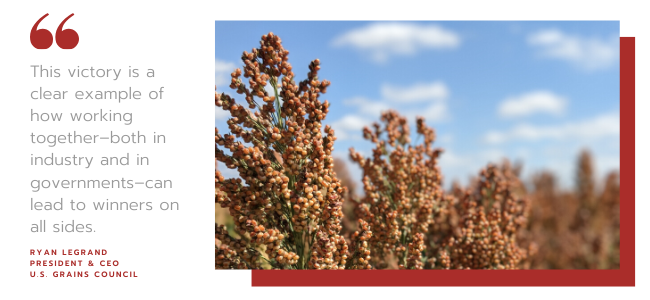A new pest risk assessment has been approved by both the U.S. Department of Agriculture (USDA) and Vietnam’s Ministry of Agriculture and Rural Development (MARD), opening the door for U.S. sorghum to flow into the country for high-value uses including pet food and liquor as well as a feed product for the aquaculture, poultry and swine industries.
This opening follows nearly five years of collaborative efforts by the U.S. Grains Council (USGC), the United Sorghum Checkoff Program (USCP) and the National Sorghum Producers (NSP) and work with the U.S. Department of Agriculture’s Foreign Agricultural Service (USDA-FAS) and Animal and Plant Health Inspection Service (USDA-APHIS), as well as regulators and industry in Vietnam.
It also highlights the importance of addressing a wide range of constraints to new demand opportunities for U.S. ag products and collaboration among U.S. agriculture groups with access to specialized knowledge about the many details of commodity exports.
“We are excited to see our hard work and collaboration pay off in Vietnam,” said USGC President and CEO Ryan LeGrand. “It’s been a long time coming but is a model of how by working together with industry and government good things can happen for U.S. commodities.”
“From an initial visit in 2015 by USCP and the USGC to discover the potential for sorghum in various marketplaces, to the development of a fish feeding trial followed by the release of very positive trial results, our organizations have worked to create opportunity for U.S. sorghum in Vietnam,” said Sorghum Checkoff Executive Director Florentino Lopez. “Of course, all this work would fall short without organizations like NSP that came in along the way to help steward the approvals needed to make it official. Our persistence has paid off, creating additional market opportunity for U.S. sorghum farmers.”
Work on the pest risk assessment – which outlines how U.S. sorghum must be handled to meet regulations in Vietnam – became even more critical after a vessel of sorghum originally destined for China in April 2018 was diverted to Vietnam but couldn’t be delivered because there was no pest risk assessment protocol in place.
The biggest lift during the process was establishing documentation from the industry to pass to APHIS, which then worked with Policy and Program Development on the agreement, led by USCP and NSP. USGC and both sorghum groups, along with their members, worked with FAS in Hanoi to complete the assessment.
For years, the Council and USCP have been working in country to assess potential markets for U.S. sorghum, including feeding trials to test the viability of replacing cassava with sorghum in Pangasius, a large catfish species native to Southeast Asian diets. Annual catfish production in Vietnam alone is 2.4 million tons.
The groups also hosted a delegation from the Vietnam Ministry of Agriculture and Rural Development’s (MARD) Plant Protection Division (PPD) in February to meet with representatives from the Sorghum Checkoff, FAS, APHIS and USDA’s Federal Grain Inspection Service (FGIS). In addition to attending several meetings, the delegation visited the Port of Houston to observe grain loading and met with agribusiness representatives.
Official approval from USDA-APHIS coupled with Vietnam’s pest risk assessment approval opens the door for Vietnam’s PPD to issue import licenses when Vietnamese importers request one for sorghum.
Sorghum is attractive to Vietnamese buyers seeking to diversify their sources of energy in feed and find feed sources that store better in local climates. Sorghum is gluten-free and non-biotech, which is also attractive to niche sectors in Vietnam, including the pet food industry.
The groundwork the Council, USCP and NSP built in Southeast Asia’s aquaculture sector was a critical step in seeing this opportunity to diversify U.S. sorghum’s export markets and create a pathway for U.S. sorghum into one of the fastest growing food-producing sectors in the world.
“This is an excellent model of how organizations can work together to create opportunities for U.S. farmers,” said Tim Lust, NSP and USCP CEO. “We anticipate building lasting relationships with Vietnam end-users, and we look forward to the opportunity to help meet their feed grain needs.”
“This victory is a clear example of how working together–both in industry and in governments–can lead to winners on all sides,” LeGrand said. “Vietnam will be able to meet its country’s grain and feed demands, and U.S. sorghum farmers will have access to a market that has several different sectors as potential end users for their product.”
Learn about sorghum export market development from the Council, the Sorghum Checkoff and NSP.
About The U.S. Grains Council
The U.S. Grains Council develops export markets for U.S. barley, corn, sorghum and related products including distiller’s dried grains with solubles (DDGS) and ethanol. With full-time presence in 28 locations, the Council operates programs in more than 50 countries and the European Union. The Council believes exports are vital to global economic development and to U.S. agriculture’s profitability. Detailed information about the Council and its programs is online at www.grains.org.

